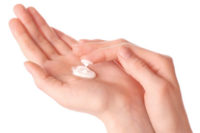This article focuses on the needs of outdoor workers.
Sun worshipers and outdoor workers must protect from our primary source of UV rays (the sun). Still, others may be exposed to harmful UV rays from non-solar sources including arc-welding, lights used to cure certain paints and inks, tanning beds and germicidal lamps.
What is UV radiation?
UV radiation is “that portion of the electromagnetic spectrum between x-rays and visible light, i.e., between 40 and 400 nm (30-3 eV).”1 When skin is exposed to UV light, it increases the production of melanin, which is the dark pigment in your skin’s epidermis that gives your skin its color.
But a person’s genetics determine the quantity of melanin produced, and many of us cannot produce sufficient melanin to provide adequate skin protection. UV rays are present even if the sun is not brightly shinning, so sunburns can occur on cloudy days. In fact, up to 90 percent of UV rays pass through clouds.2
OSHA Regulation 1910.132(a)
Employers are required to provide PPE wherever necessary, including when workers are exposed to environmental hazards capable of causing injury to any body part by physical contact.3
Clothing
The Skin Cancer Foundation states that clothing is the “single most effective form of sun protection.” 4 A tightly woven or closely knitted material (example: denim) blocks more rays than a loosely woven fabric.
Fiber type is also important. While offering great skin comfort, cotton offers the least barrier. Synthetic and semi-synthetic materials (examples: polyester, rayon) provide better protection.
The thickness of fabric should be considered. Thin fabrics (example: silk) allow more rays to pass through to the skin than denser fabrics.
Fabric color is also important, because dark or bright colors absorb more UVR than pastels or white.
Garments with a UPF (ultraviolet protection factor) label will identify the best level of UV protection.
Sunscreen
Research demonstrates that most people only apply 25 to 50 percent of the recommended amount of sunscreen, which is one ounce for the entire body, or enough to fill a shot glass. The relationship between the sun protection factor (SPF) and amount applied is not a linear one. For example, if only half the proper amount of SPF 15 is applied, the actual in-use SPF would be approximately 5, which is then inadequate protection.”5
Changing FDA Sunscreen Guidelines
In June 2011, the FDA announced significant changes to sunscreen product guidelines. Claims to reduce the risk of skin cancer can only be used on Broad Spectrum sunscreens with an SPF of 15 or higher. Non-Broad Spectrum sunscreens and Broad Spectrum sunscreens with an SPF value between 2 and 14 can only claim to help prevent sunburn.
Sunscreens labeled “water resistant” are required to state whether the sunscreen remains effective for 40 or 80 minutes when swimming or sweating. And all sunscreens will be required to provide directions on when to reapply.
Hats
A hat with a 2-inch to 3-inch brim (not baseball type caps) should be worn to help protect the neck, ears, eyes, forehead, nose and scalp. Ideally, the underside of the brim would consist of a dark, non-reflective material.
Glasses
For outdoor workers, sunglasses covering the eyes and surrounding area are a must. Look for a label showing UV protection of 99-100 percent. When working around water or other reflective surfaces, including snow, eye protection is critical, as ABC News journalist Anderson Cooper discovered in December 2012. While on assignment near the water, Cooper’s eyeballs were burned by reflected UV rays, causing temporary blindness.6 The American Academy of Ophthalmology tells us that UV light affects both the external surface and the internal structure of the eyes, and is a risk factor in developing cataracts and macular degeneration.7
Skin Cancer: What is it?
The discomfort of sunburn is a minor problem versus the threat of developing skin cancer. Skin cancer is the most common form of cancer in the United States, with more than 3.5 million cases diagnosed annually. The deadliest form of skin cancer is melanoma.
Skin cancer is the abnormal growth of skin cells that often develops when the skin is exposed to sunlight. These areas include the scalp, on the face, lips, ears, neck, chest, arms and hands, and legs. But skin cancer can also form in areas that are not ordinarily exposed to sunlight, such as palms and soles of feet.
Melanoma is categorized as being “noninvasive” or “invasive.” “Noninvasive” melanoma has not spread to other parts of the body and typically can be cured by surgery. “Invasive” melanoma means that cancer has spread to other organs or tissues in the body and can be life-threatening.
Informative Internet sites such as www.cancer.org (American Cancer Society) can give you details on what physical manifestations skin cancer takes. A basic example is a mole that changes size or color quickly.
Other factors that contribute to the likelihood of the development of skin cancer:
- Fair skin. Anyone, regardless of skin color, can get skin cancer. However, having less melanin in your skin provides less protection from damaging UV radiation.
- A history of sunburns. Having had one or more blistering sunburns as a child or teenager increases your risk of developing skin cancer as an adult.
- Excessive sun exposure. Anyone who spends considerable time in the sun may develop skin cancer, especially if the skin isn’t protected by sunscreen or clothing.
- Sunny or high-altitude climates. People who live in sunny, warm climates are exposed to more sunlight than are people who live in colder climates. Living at higher elevations, where the sunlight is strongest, also exposes you to more radiation.
- Moles. People who have many moles or abnormal moles are at increased risk of skin cancer. These abnormal moles — which look irregular and are generally larger than normal moles — are more likely than others to become cancerous.
- A family history of skin cancer. If one of your parents or a sibling has had skin cancer, you may have an increased risk of the disease.
- Exposure to the sun during the middle of the day. For many people, the sun’s rays are strongest between about 10 a.m. and 2 p.m. It is important to note that you can absorb UV radiation year-round, even during the winter months. By avoiding the sun between the hours of 10 a.m. and 2 p.m., you will decrease your risk of skin damage caused by exposure to UV radiation.
- Some medications can create a hypersensitivity to how the skin reacts to the sun. Example: common antibiotics, heart medications, over-the-counter pain medications (like ibuprofen), oral contraceptives and antidepressants. Photosensitivity can be managed by following the protection guides mentioned earlier in this document as well as including seeking shade when outdoors — even if that involves carrying an umbrella to provide a refuge from the UV rays.
- Some genetic-related diseases such as Psoriasis and Rosacea can increase the risk of skin cancer. Persons with these genetic conditions must also follow sun protection guidelines carefully.
Lost work time and economic impact of sunburns
In a study from the Department of Dermatology, University of Texas Medical Branch, Galveston, the economic impact of acute sunburn was presented. Based upon their sampling of Galveston beachgoers, 28 percent of the men and 10 percent of the women missed between 8-9 days of work. Extending those statistics to the total number of beach visitors annually, sunburn would create 92,720 missed work days. The economic impact for lost work and treatment may exceed $10 million.8
Summary
Shielding the skin from UV radiation is important to prevent damaging the protective function of the skin and reducing the risk of skin cancer.
OSHA regulations require employers to provide PPE to workers exposed to occupational hazards, including environmental ones such as sun exposure.
Proper use of SPF 15 sunscreen and limiting time in the sun, particularly between 10 a.m. and 2 p.m. when UV rays are most intense, will afford some protection.
Covering exposed skin with long-sleeved shirts and long pants, wearing a broad-brimmed hat and UV ray blocking sunglasses also help.
The American Cancer Society has created a fun way to remember the rules for sun protection: “Slip! Slop! Slap! Wrap!” Slip on a shirt. Slop on sunscreen. Slap on a hat. Wrap on sunglasses to protect the eyes and sensitive skin around them from ultraviolet light.
Footnotes and Sources:
1. www.hps.org/phspublications/articles/uv.html
2. www.mayoclinic.com/health/sunburn
3. http://www.osha.gov/pls/oshaweb/owadisp.show_document?p_table=STANDARDS&p_id=9777
4. www.skincancer.org/prevention/sun-protection/clothing/clothing-our-first-line-of-defense
5. www.aad.org/stories-and-news/news-releases/safeguard-your-skin-and-make-the-smart-choice-to-use-sunscreen-this-summer
6. www.abcnews.go.com/blogs/health/2012/12/05/anderson-cooper-recovers-from-sunburned-eyeballs
7. www.cameraguild.com/member-resources/safety/safety-articles/protect-your-eyes.aspx
8. The Economic Impact of Acute Sunburn; Department of Dermatology, University of Texas Medical Branch, Galveston; Warthan, Sewell, Marlow, Warthan, Wagner. Reprinted: Arch. Dermatology /Vol. 139, Aug 2003. www.archdermatol.com


